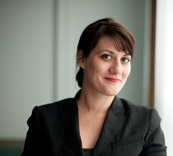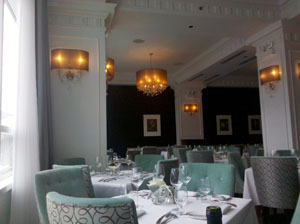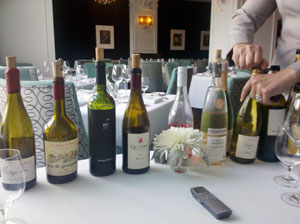| « FDA Gets Some Spiffying Up | Are You a Master Chef? » |
Feature Wed Dec 01 2010
A Lifetime Full of Wine
 Shebnem Ince remembers the flavor profile of the first wine she ever tasted. She was nine years old, and her father, who worked in a Gold Coast wine shop, would bring home bottles from the store. In their Rogers Park home, Ince (pronounced IN-ja) remembers, there was a "huge, long hall, maybe 30 feet, and he just filled that hall with wine." Her father sat down with her at the dining-room table before dinner: "He was sitting at the head of the table, and I was to his left." He opened a bottle of 1978 Spring Mountain Vineyard Chardonnay. "I just remember," says Ince, "it had this kind of golden apple and pear flavor profile, with a lot of caramel, toasty caramel. It was oaked in French oak, but I didn't know it at the time."
Shebnem Ince remembers the flavor profile of the first wine she ever tasted. She was nine years old, and her father, who worked in a Gold Coast wine shop, would bring home bottles from the store. In their Rogers Park home, Ince (pronounced IN-ja) remembers, there was a "huge, long hall, maybe 30 feet, and he just filled that hall with wine." Her father sat down with her at the dining-room table before dinner: "He was sitting at the head of the table, and I was to his left." He opened a bottle of 1978 Spring Mountain Vineyard Chardonnay. "I just remember," says Ince, "it had this kind of golden apple and pear flavor profile, with a lot of caramel, toasty caramel. It was oaked in French oak, but I didn't know it at the time."
Following her father's passion, Ince worked in his wine shop, Bragno World Wines, during high school and over the summers while at the University of Iowa, doing the daily bank deposit, cleaning, gift wrapping, and helping to carry cases. Her father, who was a singer in Turkey before coming to the States, had cultivated a huge collection to fill the half-city-block cellar underneath the store. "It was filled with bordeaux and barolo and barbaresco and burgundy," she says. "That's kind of where I cut my teeth."
She moved away from the food industry for a few years while living in Seattle after college, living with her then-boyfriend and (unsuccessfully) trying to find a writing job. She worked as a photographer, traveling in her Toyota Corolla to high schools to take pictures of the sports teams.
But she continued to build her wine knowledge over the years. Too poor to go to tastings and fancy restaurants, she would stop every day at Seattle's huge public market, with "all the fresh produce." She'd bike there from the photography studio and pick up vegetables and fish and a bottle of wine -- never the same one twice -- from one of the small wine shops nearby. "I was fixing dinner and drinking wine every night for like four and a half years, so that's a really good way to learn." Her wine memory -- she would take notes in the "wine journal of [her] mind" -- is so sharp that she remembers, for example, the first time she had a Côtes du Luberon: drinking it was "like being on a country road in France," she thought.
After Ince's son was born in 1995, she went back to work in the restaurant industry: "I wanted to work nights so I didn't have to put him in day care." With her huge amounts of wine knowledge, she was able to "sort of fake" her server knowledge, and she got a job in the four-star Dahlia Lounge. Moving back to Chicago in the early 2000s, Ince worked with the wine programs for Blackbird and mk .
But it was at Que Syrah Fine Wines, a small wine shop in Lakeview, where Ince really found her way into the Chicago wine scene. As the store's general manager, she was also responsible for its marketing, and she worked there for four years. "It was peaceful and allowed for a lot of creativity and autonomy," she says. "But it is a difficult way to scrape out a living." In 2006 restaurateur Billy Lawless hired Ince as a consultant to his new Michigan Avenue gastropub, the Gage, but he soon expanded her role to wine director and sommelier.
 In late 2009, Lawless asked Ince to curate the wine list for Henri, the fine-dining sister restaurant to the Gage, as well as serve as its wine director and sommelier. "The interior of Henri had been one of architect Louis Henri Sullivan's last Chicago commissions in 1902," Ince wrote in Organic Wine Journal in July. "This is the last of five buildings left standing of all the prolific work from this important figure in modern design. It deserves to have a distinctive wine list to match."
In late 2009, Lawless asked Ince to curate the wine list for Henri, the fine-dining sister restaurant to the Gage, as well as serve as its wine director and sommelier. "The interior of Henri had been one of architect Louis Henri Sullivan's last Chicago commissions in 1902," Ince wrote in Organic Wine Journal in July. "This is the last of five buildings left standing of all the prolific work from this important figure in modern design. It deserves to have a distinctive wine list to match."
So Ince decided to create a fully biodynamic and certified organic list, according to the rubric developed by French biodynamic viniculture pioneer Nicolas Joly. For example, to earn one star -- the minimum requirement for Ince's wine list -- the farmer can't use weed-killers or chemical fertilizers. A three-star rating, the maximum, prohibits any chemical changes that will change the wine's acidity, among other requirements.
There is a lot of misinformation about biodynamic viniculture, she says. Many articles about the process focus on its New Age-esqe aspects, like the mostly ritualistic burial of the manure-filled cow horn -- farmers bury the dung-stuffed horn at the fertile time, and during the wintertime, they bury one stuffed with silica. This practice, says Ince, reminds farmers of the time to be fertile and the time to rest. But the ritual has nothing to do with growing the grapes or the flavor of the wine, and Ince thinks it's not even worth bringing up to customers. "I don't want to talk about manure with my tables," she says. "I am not going to talk about horns, and I'm not going to talk about cow poop."
Instead, Ince focuses on how biodynamic practices help a wine express its unique origins, through a winemaker's dedicated, intensive focus. "You have to be really present, physically and mentally," she says, during the farming process. "You have to be out there pruning, you have to be out there making sure your cover crops are alive, you have to be out there looking and seeing what pests are there and how you combat them naturally." And winemakers also have to remain vigilant during fermentation, using naturally grown yeast instead of exogenous yeast.
Henri's wine menu includes statements on biodynamics from two of Ince's inspirations: winemakers Alois Lageder (Alto Adige, Italy) and Ted Lemon (Sonoma County). "A farmer working in harmony with the forces, rhythms, and cycles of nature improves the health of the soil," writes Lageder, "increases the vitality of the grapevines, and thus, as well, the quality of the grapes he harvests."
"Through careful observation of our farms," Lemon writes, "we can learn to apply less invasive techniques and more natural materials, we can re-learn what our ancestors felt intuitively, how to work with the rhythms of nature."
I met with Ince at Henri in early September, about two weeks after the restaurant opened, to taste a selection of her biodynamic wines. She asked me to come around 3pm (they had not yet started serving lunch): At that time of the afternoon, in late summer, she said, "the light at Henri is breathtakingly beautiful." The 65-seat interior, with its robins-egg blue, brown, and gold shades, look fit to seat royalty -- or at least those who can afford the restaurant's expensive menu.
 We sat by a window overlooking Michigan Avenue, and Ince set nine open bottles of wine on the table. We'll talk about some of the restaurant's glass pours, she said. (The wine menu changes about every six weeks -- depending on how much Henri has in stock or if Ince is "tired of seeing the same bottle everyday" -- so some of the glasses I tasted are no longer on the menu.) Since I'm trying to develop my palate and learn how to taste wine, she offered to break each glass pour down with me, talking me through the look, smell, and taste and trying to help me understand the individual flavors within each bottle. One of the unique elements of biodynamic wines are the honey flavor present in so many of them: "In a lot of biodynamic wines," she explained, "you have an extra layer of ripeness because the vines and the stems themselves and the seeds become more physiologically ripe. I don't know why, but it happens. The plants' ability to ripen at an even rate, like the soluble grape sugars in the pulp, are in tune with the seeds and the skin and the stems."
We sat by a window overlooking Michigan Avenue, and Ince set nine open bottles of wine on the table. We'll talk about some of the restaurant's glass pours, she said. (The wine menu changes about every six weeks -- depending on how much Henri has in stock or if Ince is "tired of seeing the same bottle everyday" -- so some of the glasses I tasted are no longer on the menu.) Since I'm trying to develop my palate and learn how to taste wine, she offered to break each glass pour down with me, talking me through the look, smell, and taste and trying to help me understand the individual flavors within each bottle. One of the unique elements of biodynamic wines are the honey flavor present in so many of them: "In a lot of biodynamic wines," she explained, "you have an extra layer of ripeness because the vines and the stems themselves and the seeds become more physiologically ripe. I don't know why, but it happens. The plants' ability to ripen at an even rate, like the soluble grape sugars in the pulp, are in tune with the seeds and the skin and the stems."
The technique of component tasting that we practiced, Ince says, didn't happen back when she first started tasting wine, when her father sat with her at the dining-room table. At that time, wine wasn't even broken down into varietal terms, like pinot noir or sauvignon blanc. With burgundy, for example, says Ince, people "never talked about red burgundy being pinot noir." Instead, they discussed "the different vineyard sites and the expressions of their terroir" (a word Ince says as if she had a bad taste in her mouth: "It's a really complicated concept, and I think the word gets thrown around with a lot of snootiness"). Now, says Ince, "people really hyper-focus on varietals."
The shift happened in the early 1980s, with Robert Parker, a wine critic who broadened people's capacity to describe wines. Before him, there was a "limited set of adjectives," says Ince, but he "really went out there on a limb," using descriptors like "cigar ash" to describe a flavor. "It inspired people to dig a little bit deeper." The shift -- the way the media began to talk about wine and the changes in people's perceptions about wine -- would be worth a book, Ince thinks. "Maybe I should write it. I'll take a Saturday night off from Henri, and I'll write my book."
We spent a lot of time with each kind of wine, tasting about eight of the glass pours over more than an hour. Here are a few we discussed:
Domaine Herbauges Grolleau Gris (not on the menu right now)
Vin Du Pays du Val de Loire, France, 2009
The grolleau gris grape comes from France's Loire Valley, a hotbed of biodynamicism -- the valley "starts at the mouth of the Atlantic and then runs all the way down just below Paris," Ince explained. The grapes come from that section near the mouth of the Atlantic, called Nantes. "Grolleau gris grows there prolifically, but there's only like 800 acres of it on the planet." Gris, she said, means grey -- the skin is a grey-pinkish color, and the color of the wine has a salmon tinge, "because there's a little bit of skin contact" during the maceration process.
Ince then moved on to "the nose," smelling the wine to categorize the flavors. She starts with a general fruit category, she said. "On this guy, I definitely get two categories. One is citrus and one is orchard." Getting more specific, she smelled Meyer lemon, Clementine orange, and dried apricot. "The other part of the smell," she said, "is vinous" -- anything that's not a fruit. In the Domaine Herbauges, she smelled a lot of "white minerality" (the chalky minerals found in the region's soil). "I don't want to make too many generalizations," Ince said, "but a lot of times old-world wines exhibit higher amounts of minerality. She also got whiffs of white and yellow meadow flowers, like buttercups and clovers.
The next step, she says, "is to just confirm. You know that old Radiohead song, 'No Surprises'? You don't want any alarms or surprises when you're tasting it. If you smell citrus and apricot like we did, you don't want plums and cherries in the mouth." And she only swallows a tiny bit of the wine. ("There are days when I taste 70 wines -- could you imagine?" she laughed. "I'm already on the train singing to myself!") It's just to test the finish, how long it takes for the wine's essence to leave her body.
Domaine du Vieux Chene Côtes du Rhône Rosé 'Cuvée des Capucines'
(dry rosé of Grenache and Cinsault) Southern Rhône Valley, France 2009
In the States, rosé gets a bad rap, said Ince. It's really sweet. But in France, where the rosé is dry, they'll drink it year-round (mainly because it's high alcohol and cheap). "You go to Paris in, like, February, and everybody's just drinking pink wine."
Rosé was "born out of not wanting to waste stuff," Ince says. When winemakers make red wine, during the fermentation period, they leave the skins in contact with the juice. To try to "concentrate the amount of skins to liquid," they remove some of the liquid, called "free-run juice," which comes out pink.
This particular wine comes from the Rhône valley in Southern France, and it's a medium-light pink color. With rosé, says Ince, "you expect light fruit, like strawberries and raspberries. ... And then red flowers."
When it comes to food pairing, rosé works with everything -- green vegetables, soups, tomatoes, meat. Most of the customers who come into Henri aren't afraid to try the rosé -- "maybe they've traveled," says Ince, "or they've just been exposed" to dry rosés. But if the customer asks for white zinfandel, "you know not to give them this. They want something sweeter or low alcohol."
Alma Negra Bonarda/Malbec
Mendoza, Argentina 2006
This wine, says Ince, is a blend of malbec and bonarda, a grape that mainly grows in Argentina. It's aged in new French and American oak, "so what you're going to get out of these guys is vanilla, baking spices, sometimes dill" -- wood imparts these smells. The alcohol content is high, which is common in the warmer climates.
"There's a lot of power in the nose," Ince says after sniffing. "A lot of dark fruit, like blueberry, dark plum. There are a lot of berries, bramble, the vanilla." We sip. "A really, pleasurable, long finish," she says. "The nose is very, very strong, but I think the palate's a little softer."









Dan G / December 1, 2010 3:22 PM
Sadly, though, some of the weakest wine service I've had in Chicago.